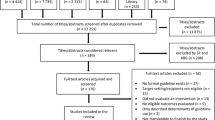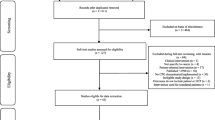Abstract
Background/Objectives
Internationally, numerous clinical practice guidelines have been developed and disseminated with the intention of improving patient care. Research indicates that to improve practice in accord with clinical evidence, change is required by individual clinicians and teams of clinicians as well as at an organizational and policy level. A matrix framework has been developed by the Australian Cancer Network’s Guideline Implementation Steering Committee, using the theory of innovation adoption. The matrix is based on the characteristics of innovations that favor rapid adoption and wide acceptance. Within this construct, new clinical guidelines are equated to an ‘innovation’. The objective of the present study was to pilot this matrix tool to assess its usefulness for individuals and organizations aiming to develop strategies to promote guideline implementation in cancer care.
Methods
The matrix was piloted at a workshop with 50 attendees, primarily colorectal surgeons and oncologists. Six key areas relating to guidelines were included in the matrix: (i) compatibility with current practice; (ii) relative advantage over current practice; (iii) observability of outcomes; (iv) trialability; (v) simplicity of use; and (vi) perceived barriers. Three examples of guideline recommendations for the management of colorectal cancer were used during the pilot, covering evidence about best clinical care and psychosocial support: (i) people with high-risk rectal cancer should be referred for consideration of adjuvant preoperative or postoperative radiotherapy in a multidisciplinary setting; (ii) people with resected Dukes’ C (i.e. node-positive) colon cancer should be referred for consideration of adjuvant therapy in a multidisciplinary setting; and (iii) psychosocial interventions should be a component of care as they can improve the quality of life in patients with cancer. After discussion of the guideline examples, the attendees completed matrix tool forms to document their perceptions regarding the consistency of current practice with the example guidelines and barriers to practice change. Quantitative responses were assessed by frequency analysis and qualitative responses were assessed by thematic analysis.
Results
There was consistency in the perceived views of workshop attendees around the six key areas included in the matrix. The perceived barriers that were highlighted by the respondents included the lack of available resources (staff, equipment, and funding); lack of multidisciplinary clinics, referral processes, and access to appropriate services; and lack of knowledge of benefit. Perceived facilitators of change included lead clinicians, consumer advocates, government, service administration, professional colleges, and cancer organizations.
Conclusions
The pilot process indicated that the matrix is a tool that could be of use to groups and individuals aiming to develop targeted change strategies to promote evidence-based practice improvement.



Similar content being viewed by others
References
CancerStats Monograph 2004. London, UK: Cancer Research UK, 2004
National Breast Cancer Centre. Clinical practice guidelines for the management of early breast cancer. 2nd ed. Canberra, Australia: National Breast Cancer Centre, 2001
Australian Cancer Network and National Breast Cancer Centre. Clinical practice guidelines for the management of women with epithelial ovarian cancer. Sydney, Australia: National Breast Cancer Centre, 2004
Clinical Oncological Society of Australia and Australian Cancer Network. Guidelines for the prevention, early detection and management of colorectal cancer. Canberra, Australia: National Health and Medical Research Council, 1999
Australian Cancer Network. Clinical practice guidelines for the prevention, diagnosis and management of lung cancer. Sydney, Australia: The Cancer Council Australia, 2004
Hill D, Jamrozik K, White V, et al. Surgical management of breast cancer in Australia in 1995. Sydney, Australia: National Breast Cancer Centre, 1999
Clinical Governance Unit 2002. The national colorectal cancer care survey: Australian clinical practice in 2000. Melbourne, Australia: National Cancer Control Initiative, 2002
AGREE Collaboration. Development and validation of an international appraisal instrument for assessing the quality of clinical practice guidelines: the AGREE project. Qual Saf Health Care 2003; 12: 18–23
Vlayen J, Aertgeerts B, Hannes K, et al. A systematic review of appraisal tools for clinical practice guidelines: multiple similarities and one common deficit. Int J Qual Health Care 2005 Jun; 17(3): 235–42
Grol R. Beliefs and evidence in changing clinical practice. BMJ 1997; 315: 418–21
Grol R, Grimshaw J. Evidence-based implementation of evidence-based medicine. Jt Comm J Qual Improv 1999; 25: 503–21
Oxman A, Thomson MA, Davis DA, et al. No magic bullets: a systematic review of 102 trials of interventions to improve professional practice. CMAJ 1995; 153: 1423–31
Bero LA, Grilli R, Grimshaw JM, et al. Getting research findings into practice: closing the gap between research and practice. An overview of systematic reviews of interventions to promote the implementation of research findings. BMJ 1998; 317: 465–8
Ellrodt AG, Conner L, Riedinger M, et al. Measuring and improving physician compliance with clinical practice guidelines. Ann Intern Med 1995; 122: 277–82
Grimshaw JM, Thomas RE, MacLennan, et al. Effectiveness and efficiency of guideline dissemination and implementation strategies. Health Technol Assess 2004; 8(6): 1–85
Grimshaw JM, Eccles MP. Is evidence-based implementation of evidence-based care possible? Med J Aust 2004; 180: S50–1
Moss F, Garside P, Dawson S. Organisational change: key to quality improvement. Qual Health Care 1998; 7 Suppl.: S1–2
Sonnad SS. Organizational tactics for the successful assimilation of medical practice guidelines. Health Care Manage Rev 1998; 23: 30–7
Ferlie E, Fitzgerald L, Wood M. Getting evidence into clinical practice: an organisational behaviour perspective. J Health Serv Res Policy 2000; 2: 96–102
Davis DA, Taylor-Vaisey A. Translating guidelines into practice: a systematic review of theoretical concepts, practical experience and research evidence in the adoption of clinical practice guidelines. CMAJ 1997; 157: 408–16
Hindle D, Natsagdorj T. Treating organizational illness: a practical approach to facilitating improvements in health care. Aust Health Rev 2002; 25: 171–80
Rogers EM. New product adoption and diffusion. J Consum Res 1976; 2: 290–301
Rogers EM. Diffusion of innovations. 4th ed. New York (NY): The Free Press, 1995
Sanson-Fisher RW, Grimshaw JM, Eccles MP. The science of changing providers’ behaviour: the missing link in evidence-based practice. Med J Aust 2004; 180: 205–6
Cabana MD, Rand CS, Powe NR, et al. Why don’t physicians follow clinical practice guidelines? A framework for improvement. JAMA 1999; 282: 1458–65
Acknowledgments
We would like to thank the Colorectal Group of the Victorian Cooperative Oncology Group for piloting the matrix tool, and Susan Fitzpatrick (The Cancer Council Victoria) and Fiona Booth (National Breast Cancer Centre) for assistance with collation of the resultant data.
The authors did not receive any funding to assist with preparation of this study and have no conflict of interest related to the contents of the study.
Author information
Authors and Affiliations
Corresponding author
Rights and permissions
About this article
Cite this article
Luxford, K., Hill, D. & Bell, R. Promoting the Implementation of Best-Practice Guidelines Using a Matrix Tool. Dis-Manage-Health-Outcomes 14, 85–90 (2006). https://doi.org/10.2165/00115677-200614020-00003
Published:
Issue Date:
DOI: https://doi.org/10.2165/00115677-200614020-00003




